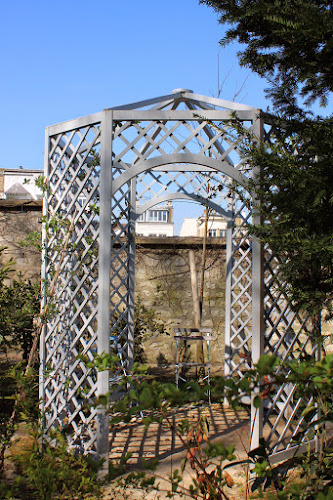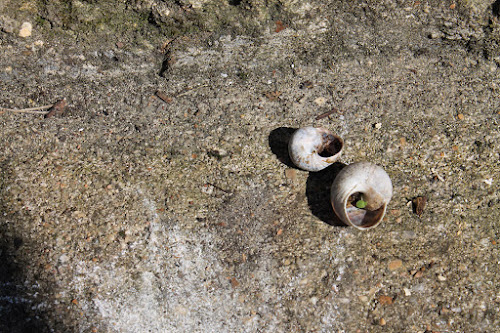Ostermontag früh um 9 Uhr und wir haben die Straßen von Paris ganz für uns alleine, aber das können wir nur bedingt genießen, denn wir sind ganz doll müde und entscheiden uns eher dafür, die Schlafcouch in Sabas Mansardenzimmerchen zu teilen. Das wird vermutlich auch das letzte Mal gewesen sein, Saba macht ihren Master und kommt in zwei Wochen nach Berlin zurück. Ich in drei Tagen; reise schon mal voraus mit viel Gepäck. Aber erst einmal genieße ich mein verlängertes Wochenende. Lange schlafen, kurzer Spaziergang zur weißen Kirche, schnell wieder weg, um nicht im Touristenpulk verloren zu gehen, schönes Wetter und Ferien hat auch viele Nachteile, abends einen Cocktail und Crêpes mit Zucker. Ich mag Paris, aber ich muss ja hier nicht wohnen.
Ein bisschen Tourist bin ich dann aber doch noch. Ich besuche das Musée de Montmartre. Es umfasst mehrere Gebäude, in denen Künstler wie Renoir ihr Atelier hatten oder gelebt haben, wie Suzanne Valadon und ihr Sohn Maurice Utrillo, dessen Grab ich auf dem kleinen Friedhof vor dem Haus meiner Tochter gesehen habe (http://fraumb-far-far-away.blogspot.jp/2014/04/fruhling-auf-dem-montmartre-spring-at.html). Neben den Gebäuden, die Fotografien, Gemälde, ein riesiges Scherenschnitt-Theater, Plakate und Gebrauchsgegenstände aus der Geschichte des Viertels zeigen, gehören zum Museum die Renoir-Gärten und der Weinberg.
Den Weinberg gibt es hier schon seit dem Mittelalter, aber im Jahr 1933 wurde er neu bepflanzt. Die Gärten wurden nach den Gemälden Renoirs wieder hergestellt, und so findet man hier die Schaukel und die Gartenlaube wieder, und das Haus Rue Cortot 12, eines der ältesten Häuser hier, aus dem 17. Jahrhundert stammend, sieht heute noch genauso aus wie damals, obwohl es nun aus dem Jahr 1959 stammt und eigens für das Museum wieder gebaut wurde. Von den Gärten, die im Moment von fleißigen GärtnerInnen, von den einige aussehen, als seien sie den Bildern der Impressionisten entstiegen, mit Sommerblumen bepflanzt werden, hat man einen schönen Ausblick über den Weinberg und das Ende der Rue de Saules, des Weidenwegs, an dem schon lange keine Weiden mehr stehen. Und doch kann man sich wegträumen in die Zeit der Boheme, der Künstler und der Waschfrauen mit den vielen Unterröcken, in eine Zeit, die so besonders und so aufregend war...
Dann gehe ins Museum und werde empfangen von einer slide show alter Fotografien: Montmarte der alten Zeit. Und dann denke ich, ja, die Ecke kennst du, ja, genau, da ist jetzt dieses oder jenes anders als einst, oder, nein, das sieht jetzt ganz anders aus, und das Haus, oder die Mühle gibt es so nicht mehr. Und ich denke noch, dass die alten Zeiten vielleicht gar nicht so aufregend und interessant waren, nicht für die Normalverbraucher, nicht für Leute, die in einer Mansarde gelebt haben, so groß, wie das Studio meiner Tochter, sich dieses aber zu viert geteilt haben und das Wasser von der Pumpe im Hof geholt haben.
Neben der Eingangshalle mit den Fotos taucht man ganz tief in die Geschichte der Gegend ein. Der Name impliziert, dass hier Märtyrer den Tod fanden, und ja, es gab auch eine Hinrichtungsstätte, aber wo gab es die nicht. Zuvor, also bei den Römern hieß der 130 Meter hohe Hügel im Norden von Paris Mons Merkore oder Mons Mars, und es gab zwei Tempel hier, einer dem Handelsgott und einer den Kriegsgott gewidmet, also den zwei Säulen des römischen Imperiums. Als die Römer weg waren, mussten auch ihre Tempel weichen, und es wurde die Kirche Saint Pierre du Montmartre errichtet, sie stammt aus dem 12. Jahrhundert und ist einer der ältesten Sakralbauten in Paris. Im 16. Jahrhundert entstand ein Jesuitenkloster und die Windmühlen, die Gips mahlten. Der wurde, wie schon zur Zeit der Römer hier abgebaut, außerdem wurden die großen Weingärten angelegt.
Im 19. Jahrhundert kam Napoleon und erklärte Baron Hausmann, er solle mal die Stadt neubauen, dieser ließ bauen, der Baustoff kam vom Montmartre, und weil das Leben in Paris plötzlich sehr teuer wurde, zogen die Leute weg aus der großen Stadt, in die umliegenden Dörfer, auch nach Montmartre. Napoleon war dann mal weg, die Welt erobern, bis 1814, da war er wieder zurück und mit der Erstürmung des Montmartre war der Krieg dann vorbei. 1859 wurde das Dorf, wie andere auch, eingemeindet, aber irgendwie blieb es Montmartre. 1871 nach Beendigung des Deutsch-Französischen Krieges war der Montmartre die Wiege der Pariser Kommune, die gewaltsam niedergeschlagen wurde. Als Entschuldigung für die Sünden der Kommunarden und zu Ehren der Opfer des des Krieges beschloß die Nationalversammlung den Bau der Kirche Sacré-Cœur, welche 1919 geweiht wurde, als der nächste, noch furchtbarere Krieg vorbei war. Die Kirche, heute das Sinnbild des Bezirks, wurde zur Zeit ihrer Entstehung eher verlacht oder beschimpft, wie die Unterröcke einer Hure sehe sie aus. Viele Bewohner gingen zur Messe in andere Kirchen, liefen oder führen lieber weit, nur um nicht in dieser Scheußlichkeit beten zu müssen.
Und natürlich wohnten hier die Künstler. Die Kunst ist meist eine brotlose welche, Paris war teuer, Montmartre weniger, und so kamen sie hier her, Renoir, Toulouse-Lautrec, Steinlen, o.g. Suzanne Valden und Utrillo, in deren Haus ich gerade bin. Später kamen auch Picasso, Braque und Modigliani. Sie trafen sich in Wirtsstuben, Kabaretts und Tanzlokalen, wie dem "La Mère Catherine" (seit 1793), „Le Billard en Bois" (heute La Bonne Franquette), „Au Rendezvous des Voleurs" (1860, heute Le Lapin Agile), Le Moulin de la Galette (Vergnügungslokal seit 1870), Le Chat Noir (1881) und Le Moulin Rouge (1889). Am agilen Hasen, Lapin Agile bin ich immer vorbei gelaufen, wenn ich auf den Berg gestiegen bin. Und nach zehn Besuchen in der Seine-Metropole, habe ich die Idee, dass der Montmartre ein besonderer Ort ist, es ist etwas feinstoffliches, etwas, auf das ich nicht den Finger legen kann, aber sicher haben die Künstler das auch gespürt und vielleicht war der Montmartre darum der Ort, an dem sie sein mussten und sein zu können.
Dann kam der erste Weltkrieg, und die Künstler ließen sich nun in Montparnasse nieder und am Fuße des Hügels entstand das Rotlichtviertel und die Filmfabrik "Pathé-Studios", die bis in die 90er Jahre prägend für den französischen Film war. Heute ist der Bezirk Touristenmagnet und Afrikanerghetto, wie meine Tochter salopp formulierte. Die Gegend um den Cimetiére de Montmartre und um die Moulin de La Galette sind eher ruhig und beschaulich und hier kann man den verblichenen Charme früherer Zeiten noch erspüren.
Aber da der Montmartre sich immer wieder neu erfindet, warten wir einfach, was noch kommt. Und gegen die momentane Wehmut hilft der Film "Die fabelhafte Welt der Amélie".
It's Easter Monday 9am and the streets in Paris are ours, but we are far from enjoying that, because we are totally tiered and choose to share the sofa bed in Saba's tiny attic. That will probably be the last time, Saba is finishing her Master and will be back in Berlin in two weeks. Me will back in three days, will travel ahead with some luggage. But first I enjoy my enlarged weekend, long sleep, short walk to the White Church, but soon I'll leave that, to avoid to get swallowed in the tourist's crowd, holiday and beautiful weather got drawbacks too, in the evening we have cocktails and crêpes with sugar, I like Paris, I don't have to live there.
But I do a little bit touristic stuff too. I go and see the "Musée de Montmartre". It contains several buildings, where artists like Renoir had their ateliers or artists like Suzanne Valadon and her son Maurice Utrillo had lived. I found his grave at the small cemetery in front of the house my daughter is living in (http://fraumb-far-far-away.blogspot.jp/2014/04/fruhling-auf-dem-montmartre-spring-at.html). Beside the house were you can find paintings, drawings, wall posters, a huge silhouette theatre, photographs and everyday items of the area also the Renoir Gardens and the wine yards belong to the museum.
The vine yard has been here since them medieval age but was replanted in 1933. The gardens were reconstructed after the paintings of Renoir, and so you find here the swing and the gazebo and the house Nr.12 Rue Cortot, one of the oldest houses around, built in the 17. century, looks exactly like in the old time, even it is an replacement of the original, built in 1959 for the museum. From the gardens, which were filled with summer flowers right now from gardeners, who looks like they came out of some impressionist paintings right away, you got a beautiful look over the wine yard and the end of the Rue des Saules, the Willow Way, where they aren't any willows since a long time, but you can dream away yourself into the time of La Bohème, the artist, and the washing ladies with the many underskirts. A time that was so special and exciting...
Than I enter the museum and are welcomed by a slide show of old photographs: Montmartre in the old times. And I think to myself, yes, I know that corner, yes, exactly, but this and that looks different now, or no, that house or that mill isn't there anymore. And I also think, that those old times may not have been that exciting or interesting for the common people, not for those living in an attic like the studio of my daughter, but had to share it with four people and had to get the water from the pump in the yard.
Next to the hall way with the photographs you dive deep into the history of the quarter. The name implies that martyrs met their fate here, and yes,there was a place of execution, but at least, they were everywhere, weren't they. A bit long ago, at the Roman Time the 130 meter high hill in the north of Paris was called mons mercure or mons mars, and two temples have been there, one to worship the God of trade and one for the God of war, two pillars of the Roman Imperium. When the Roman had to leave, the temples had too, instead a church was built, St. Pierre de Montmartre, the oldest sacred building of Paris, built back in the 12. century. In the 16. century a Jesuit College was founded and the wind mills were constructed, those which grind the cast. They mined that here like already the Romans did and and the big wine yards were built too.
The 19. century came and with it Napoleon, he told Baron Hausmann to renew the city and he did so, the materials came from Montmarte. And life then became expensive in Paris, so people moved away, into the surrounding villages, for example Montmarte. Napoleon was on his way then to take the world, until 1814, than he came back and with the storming of Montmarte the war was done. 1859 the village was incorporated like others too, but was still Montmarte. In 1871, after the German-French war was lost, Montmarte was the cradle of the Paris Commune, which was stamped down violently. As an apology for the sins of the communards and to honour the dead of the war the National Assembly decided to build a new church, Sacré Cœur, which was sacred in 1919, after the next, much more terrifying war was over. The church, nowadays a symbol for the quarter, was a nuisance for the people back then, they were laughing at it or ranting, it would look like the underskirts of a whore, and they rather walked or rode far for service than did pray in that hideosity.
And of course the artist did live here, arts are mostly unprofitable ones, and Paris was expensive, but Montmarte wasn't, not that much. So they all came, Renoir, Van Gogh, Steinlen, Suzanne Valadon and Utrillo, in whose house I'm at the moment, later Picasso, Braque and Modigliani. They met in inns, cabarets and dance houses like the "La Mère Catherine" (since 1793), „Le Billard en Bois" (today La Bonne Franquette), „Au Rendezvous des Voleurs" (1860, today Le Lapin Agile), Le Moulin de la Galette (place of amusement since 1870), Le Chat Noir (1881) und Le Moulin Rouge (1889). I often passed the agile hare, le Lapin Agile when I climbed up the hill. And since I've been in Paris about ten times, I got the idea that there is something special about Montmarte, something subtle, where I can't put my finger on, but maybe the artist felt the same, and they had to be here, to be.
Then followed the First World War and the artists left for Montparnasse, at the foot of the hill the red-light district rose up and the film factory "Pathé Studios" which was defining the French cinema scene till the 90s, when it was closed. Today the place is a tourists magnetic and the African Ghetto, like my daughter put it crudely. The area around the Cimetiére de Montmarte and the Moulin de la Galette are more quiet and spray the fading charm of long gone times.
But Montmarte reinvents itself again and again and so we just wait, what will come along, and against the melancholy may help the movie "Amélie".








































































































Keine Kommentare:
Kommentar veröffentlichen